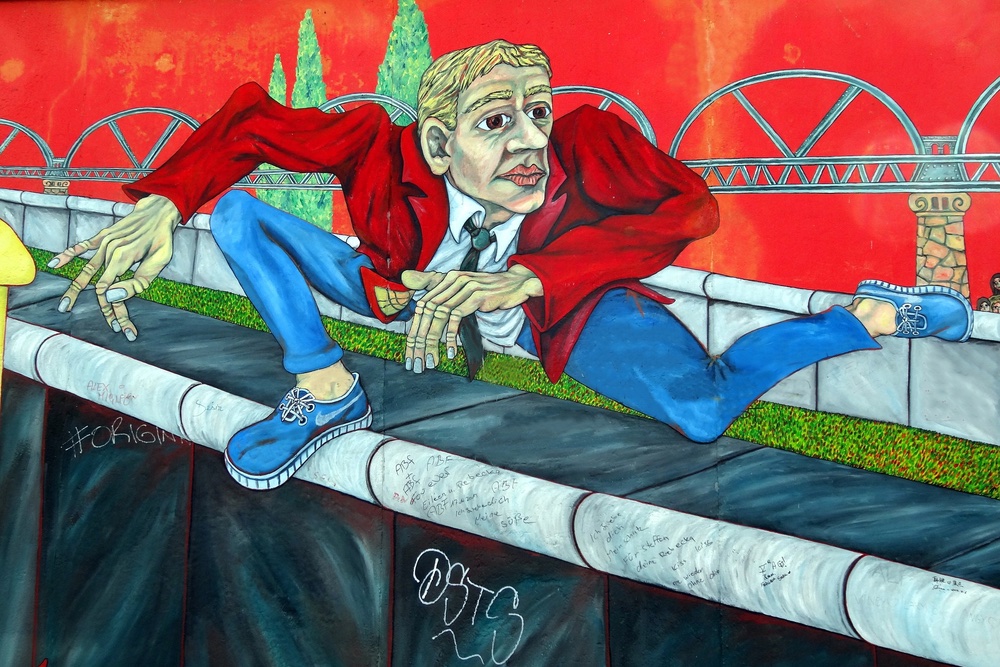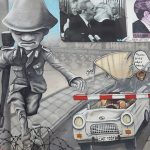
On 1 December 1955, the border police took over securing the entire state border of the GDR to the west and east. Only the border to West Berlin was subject to the still solely to the Soviet administration in Berlin.
Already since the 25 August 1952, the first 543 honorary Border police helpers (Without legal basis) were deployed. Their small number should The fact that the helpers who were loyal to the line were theoretically reliable outweighed the disadvantages.
But that was wishful thinking. They were too few and by no means all reliable. So wanted an official border guard assistance force. The new Volunteers were formed six years after the formation of the People’s Police Volunteers. On 5 June 1958 they were legally anchored in the GDR’s state system.
This happened three years before the Wall was built. From the point of view of the state leadership, the increasing number of Republic refugees made it necessary to increase surveillance of the border region.
The introduction to the Ordinance reads:
„The working population of the border districts of the German Democratic Republic has often expressed the wish to be able to support the German Border Police in guaranteeing the inviolability of the borders of the German Democratic Republic and in preventing border violations through voluntary work.“
The propaganda was primarily about warding off encroachments from the capitalist foreign countries. Joining the Warsaw Pact on 14 May 1955 had turned the German-German border into a dividing line between the military blocs.
The appeals and propaganda work, not least by the FDJ, brought limited success. Compared to the People’s Police, which at that time already had tens of thousands of helpers, the border helpers only had a few thousand.
After the official formation of the border guard volunteers, they were an integral part of the GDR’s border guards within the NVA until 1973. Then the border troops became a separate branch of the armed forces. This circumvented the counting as soldiers in the disarmament negotiations.
On 8 April 1964, the legal bases of the border guard volunteers and the volunteers of the People’s Police were united and combined in a new ordinance. However, the special tasks of the border troops were only touched upon in the catalogue of tasks. Officially, however, they were no longer called Helpers of the border police, but helpers of the border troops . Their The tasks were to establish the personal data and the feeding of suspected persons to the regular forces.
Most of the border guard volunteers were on duty at the inner-German border in the so-called “restricted areas”. Only persons with special permission from the MDI were allowed into these areas. The residents in these zones were under constant intensive surveillance.
After West Berlin was sealed off from the GDR, the zone border there also became the responsibility of the border troops. Helpers were also deployed at the sea border on the Baltic Sea. Many a walker on the beach was a border guard helper.
Most of the helpers were recruited from the communities on the border. The local people knew all the sneaky ways, so were Their local knowledge was used by the regular border troops for the purpose of paramilitary reconnaissance. The patrols were mostly carried out on foot, individually or in groups of two to three people.
A deployment of volunteers at the borders to Warsaw Pact states to prevent border crossings also occurred. But there it was also about preventing smuggling, because the GDR, for all its economy of scarcity, was economically strong compared to its eastern neighbours.
Many West Berliners, and other users of the transit routes, had to experience that the nice GDR citizen at the rest stop was an aide of the border troops or an official Stasi employee. They strictly monitored whether GDR citizens had contacts with the West there. So an appointment with relatives there was very risky.
Many of the volunteers of the border troops were taxi, and bus and lorry drivers and innkeepers of the area near the border. People who, by virtue of their profession, could report possible suspects or their conversations to the border troops or state security.
For every platoon leader, there were three group leaders, each of whom was in turn subordinate to nine volunteer helpers. The service was unpaid, but it was credited to soldiers as reserve service. A regular officer of the border troops was in command of the platoon leader. This was usually the platoon leader of the border section. But every regular border guard was authorised to give instructions to the volunteers. Their weekly assignment was about eight to ten hours.
For legitimation, they received, like the comrades in the People’s Police, a service card with all important personal data and powers, which had to be shown by the helper in action without being asked.
On 1 May 1982, a reform of the rules took place. The groups of the People’s Police and the border troops were formally separated. The volunteers of the border troops were again given their own legal basis, in the newly enacted Law on the State Border of the German Democratic Republic of 25 March 1982 with effect from 1 May 1982.
The powers of the border guard volunteers included first and foremost the (now confirmed) right to independently establish or record personal details if there was reasonable suspicion of a border violation or a breach of order and security in the border area. However, they could also simply take suspicious or conspicuous persons to the nearest office of the border troops or hand them over to a member of the border or people’s police. As already regulated in the first ordinance of 1964, the latter measure required only a simple suspicion. Even a large bag looked suspicious. Every stranger in the restricted area was also suspicious. The absence of an identity card was grounds for arrest.
Helpers of the border troops were expressly obliged to apprehend any fugitive. Since they were not allowed to carry weapons according to the legal basis, the “apprehension” was carried out by manual intervention. Afterwards, the “border violator” was to be handed over immediately to the regular border security organs. The operational area was set at 5 km from the border. However, the transit routes were additional operational areas.
Some helpers had private dogs that had the appropriate training in hunting humans. For a hunting dog, the trail is easy to pick up. Hunters were not officially allowed to carry their hunting weapons as helpers, but it did happen.
The training was more intensive than for the helpers of the People’s Police. This included participation in military sports exercises. As everywhere in the GDR, a large part of the training consisted of instruction in Marxism-Leninism. Basic police tactics and border police tactics, on the other hand, were only taught. striped.
The secrecy was enormous, so it is still difficult to name the number of helpers of the border troops. It was never less than 2,500, but some say it was over 4,000. For 1982, even 5,565 helpers are mentioned.
A prerequisite for employment was that the prospective border guard assistant displayed the “correct socialist attitude” as defined by the GDR leadership.
Unlike the People’s Police, the helpers had special equipment. E.G. Camouflage nets, service binoculars and similar utensils of the border troops’ service. A special “device” was an inflatable air cushion for the buttocks. A first aid kit had to be carried on duty at all times.
The clothing was civilian, but some received their clothing for bad weather directly from the NVA depots. The footwear of the volunteers in the rural border areas consisted of military boots.
Many wore the border troops’ little ship as headgear. The official sign was a wristband with the inscription “Freiwilliger Helfer der Grenztruppen”. From 1982 it was green, previously red. The GDR coat of arms was embroidered between the lines. The height of the armband was approx. 80 mm and its width 130 mm, with the national coat of arms having a diameter of approx. 20 mm.
With decree number 018/9/001, the “Volunteer Helpers” badge of the border troops was awarded on 8 April 1983. It was a small pin badge that identified the holder as a volunteer of the border troops. It was also worn off duty on the lapels of the coat or the collar of the shirt.
Only in 1982 the “Medal for Loyal Service of Volunteers in the Protection of the State Border of the GDR” was created by order of Erich Honnecker, which was a service award for up to 30 years of service with the volunteer helpers of the border troops. The award was also permitted retroactively if the helper had fulfilled the required minimum time of the respective level. The “Medal for Exemplary Border Service was actually only intended for regular members of the border troops. But helpers also received them for “extraordinary services”. This was usually the prevention of an escape.
Furthermore, the border guards also received the “Border Troops of the GDR Badge of Achievement” and a miniature for everyday life that was created especially for them.
In addition to badges of honour and medals, there were also official letters of commendation and honours in the form of certificates, which could also be associated with a monetary award or gifts in kind.
Expenses incurred on duty were reimbursed by the border troops, but there was no pay. Instead, the employee’s wages continued to be paid by the company and he was released from his duties as a helper. Accidents were covered by the company accident insurance. For the consequences of an accident, the border guard helper was entitled to benefits in kind, accident pension, care allowance, special care allowance and blind person’s allowance. In the event of death, the surviving dependants were entitled to funeral allowance and accident survivor’s pension.
On 1 July 1990, the activities of the GDR border troops came to an end. With the opening of the border the main task of the volunteers of the border troops was no longer border protection, but was limited in the last months to various support activities such as handling the increasing traffic of people and vehicles. Helpers also worked on dismantling border fences.
Since the helpers did not carry weapons, they were not implicated as perpetrators in Mauerschützen trials. However, their role is viewed very critically by most people today. As informants for the State Security, they are considered by many to have been informers. The fact is that many people fell into the machinery of the GDR authorities because of them. This by no means only affected refugees from the Republic. Not all border guards were loyal to the regime. Some were opportunistic followers who, for example, speculated on being admitted to university.
Despised and hated by large parts of the population, many helpers experienced after the fall of communism that coming to terms with the past does not always take place according to the rule of law. In individual cases, they were expelled by their neighbours. Economic boycott or dismissals destroyed many a life. Even bodily harm and arson occurred.



